Sexually Transmitted Infections in Colombian University Students: Prevalence and Associated Factors of Chlamydia trachomatis and Neisseria gonorrhoeae
Mónica Yurley Arias Guerrero 1, Jorge Alexander Silva-Sayago 2, Giovanna Rincón Cruz 3,
Ruth Aralí Martínez Vega 4, Liliana Benitez Díaz 5*
Ruth Aralí Martínez Vega 4, Liliana Benitez Díaz 5*
1 Facultad de Ciencias Médicas y de la Salud, Instituto de Investigación Masira (Universidad de Santander, Bucaramanga /Colombia); moni.arias@mail.udes.edu.co.
2 Facultad de Ciencias Médicas y de la Salud, Instituto de Investigación Masira (Universidad de Santander, Bucaramanga /Colombia); jor.silva@mail.udes.edu.co.
3 Grupo de Inmunología y Epidemiología Molecular (GIEM), Facultad de Salud - Escuela de Microbiología (Universidad Industrial de Santander, Bucaramanga /Colombia) 2; grinconc@uis.edu.co.
4 Facultad de Ciencias Médicas y de la Salud, Instituto de Investigación Masira (Universidad de Santander, Bucaramanga /Colombia); ruth.martinez@udes.edu.co.
5Maestría en Investigación en Enfermedades Infecciosas (Universidad de Santander, Bucaramanga /Colombia); lilianabenitezdiaz@gmail.com.
* Correspondence: lilianabenitezdiaz@gmail.com
ABSTRACT
Young people comprise a high-risk population for the acquisition of sexually transmitted infections (STIs). Chlamydia trachomatis (CT) and Neisseria gonorrhoeae (NG) are the most common bacterial STIs worldwide. In Colombia, STIs are underreported because epidemiological surveillance programs lack systematic searches for asymptomatic patients. The present study determined the prevalence of CT and NG infections and related factors in students at the Universidad de Santander, Bucaramanga campus, Colombia. Methods: Newly admitted students were enrolled between 2019 and 2020. A survey was conducted, and samples of vaginal secretions and male urine were self-collected. PCR was performed to detect pathogens. Results: 190 students aged 18–25 years were included. The prevalence of CT was 7.9% (15/190), and that of NG was 1.05% (2/190). Coinfections were not observed. In women, the prevalence of CT was 8.06%, and NG was not detected; in men, the prevalence of CT and NG was 7.58% and 3.03%, respectively. Ten percent reported never using condoms or having more than one partner simultaneously. Knowledge about CT and NG was poor in 90% and 76.8% of participants. Factors associated with higher prevalence of CT or NG infection were socioeconomic status (aPR 3.07, 95%CI 1.19-7.91) and urinary burning (aPR 3.63, 95%CI 1.12-11.8), while having a steady partner was associated with lower prevalence of infection (aPR 0.27; 95%CI 0.08-0.94). Conclusions: The prevalence of CT and NG was higher than that reported in previous studies on university students in Colombia. Therefore, it is necessary to implement surveillance programs and focus on preventive strategies to avoid health problems.
Keywords: Chlamydia trachomatis, Neisseria gonorrhoeae, prevalence, university students, sexually transmitted infections, molecular diagnostics, asymptomatic infection, STI screening in youth, Latin America epidemiology, self-collected samples
INTRODUCTION
Youth and adults comprise a high-risk population group for acquiring sexually transmitted infections (STIs) because they are more likely to engage in risky sexual behaviors1. STIs can trigger long-term health consequences, such as infertility, not to mention the impact on the economic burden on the health system 2. Chlamydia trachomatis (CT) and Neisseria gonorrhoeae (NG) are the most common bacterial STIs worldwide. Numerous investigations have shown that screening for CT and NG in young people and adults is an excellent strategy for preventing these infections because it identifies at-risk populations reluctant to seek medical care and makes it possible to identify those without symptoms3. The politics designed for STI surveillance and prevention are lacking in developing countries2. In Colombia, the Public Health Surveillance System (SIVIGILA) includes mandatory reports of HIV-AIDS, hepatitis B, trachoma, and gestational and congenital syphilis. However, NG surveillance is passive, voluntary, and carried out through the national network of laboratories. In the case of CT, only serotypes A, B, and C are monitored4. In Colombia, few studies have evaluated the presence of CT and NG in young people and adults5,6. Therefore, the aim was to determine the prevalence of CT and NG infections and some associated factors in a newly enrolled student population between 2019 and 2020 at the Universidad de Santander, Bucaramanga campus, Colombia.
MATERIAL AND METHODS
A cross-sectional study was conducted. The study population was comprised of newly admitted students (2019 -2020) at the Universidad de Santander, Bucaramanga campus. Participation in the study was solicited via email and telephone calls. The inclusion criteria were age between 18 and 25 years, having had sexual activity, and being affiliated with the general health system. Pregnant women were excluded.
A 40-question survey was administered covering sociodemographic data, sexual practices, STI-associated symptomatology, and knowledge of CT and NG. Vaginal secretion samples were self-collected7, and urine samples were obtained from male participants. DNA extraction and end-point PCR were performed to detect the omp and ORF genes of CT, opa, and porA genes of NG8 (Table S1). The Human hemoglobin subunit beta gen (HBB) was used as an internal extraction control 9. Each round of PCR included a negative and positive control for each pathogen. PCR specificity was assessed against the major uropathogens, and the identity of each gene was corroborated by automated Sanger sequencing10 (see details provided in the Supplementary Material). At least one gene in the PCR for CT or NG was considered an infection.
Quantitative variables were described using medians and interquartile ranges because they did not exhibit a normal distribution. Qualitative variables were reported as absolute and relative frequencies. The Wilson method calculated the prevalence of CT and NG infections with a 95% confidence interval. Univariate and multiple analyses with log-binomial regression were performed to estimate the prevalence ratio (PR) and adjusted PR (aPR), using STATA 16.0 (StataCorp LLC, USA).
Ethics Statement: All participants provided written informed consent. The project was endorsed by the Bioethics Committee of the Universidad de Santander (Approval Act 035, October 15, 2019).
RESULTS
A total of 209 student volunteers were recruited. However, 19 were excluded because HBB was absent in the samples, 17 of whom were men. The remaining 190 students included corresponded to 15.5% of the population of newly enrolled students aged 18-25 years in 2019 and 2020 (N =1229) (Figure 1). The sample distribution by faculty and sex at birth was similar to that of the population (p=0.573 and p=0.421, respectively) (data not shown). The sample consisted mainly of women (65.3%); seven (5.7%) reported having been pregnant, of which five miscarried (three spontaneous abortions), and none of these participants had infections. In addition, participants were predominantly between 18 and 20 years of age (55.8%), unmarried (63.5%), socioeconomic level stratum 3 (40.2%), and unemployed (61.1%) (Table 1). Most participants (89.5%) had parents as influential figures in their upbringing.
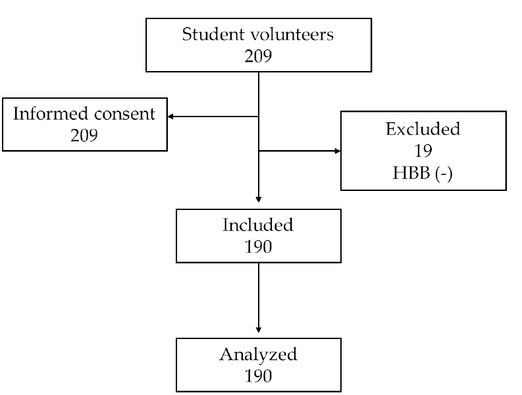
Figure 1. Flowchart of students included in the study
Regarding sexual practices, most participants initiated sexual relations between the ages of 14 and 17 years (68.9%) and were heterosexual (86.3%). A total of 50.5% reported having had more than two sexual partners at the time of the study. In addition, the majority reported using condoms (62.2%). Sexual practices with multiple partners simultaneously, the use of sex toys, and sex under the influence of alcohol or hallucinogenic substances occurred at low frequencies. Regarding the type of sexual relations, vaginal (92.6%) and oral (62.1%) relations were predominant. Of the total, 37.9% of students reported genital symptoms in the past week, with lower abdominal pain during intercourse being the most frequent, followed by abnormal genital discharge. Additionally, most students had "poor" knowledge of CT and NG (Table 1).
Concerning CT and NG infections, 8.95% (17/190; CI95% 5.66-13.86) presented either of the two STIs, with a prevalence for CT of 7.89% (15/190; CI95% 4.84-12.62) and for NG of 1.05% (2/190; CI95% 0.29-3.76). Coinfections were not observed. In women, the prevalence of CT was 8.06% (CI95% 4.44-14.21), and NG was not detected, while in men, the prevalence of CT and NG was 7.58% (CI95% 3.28-16.54) and 3.03% (CI95% 0.83-10.39), respectively (Figure 2 and Table 2).
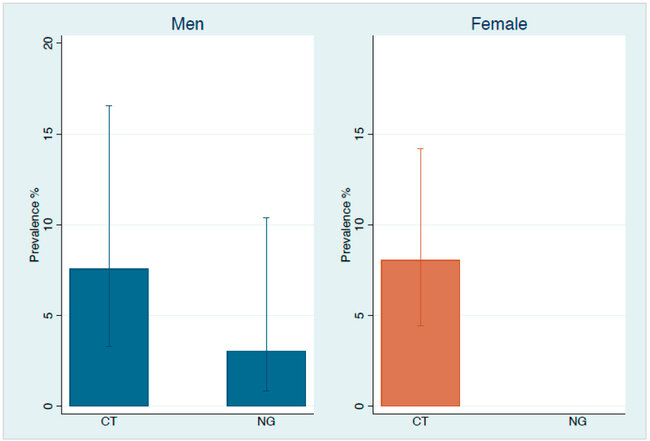
Figure 2. Prevalence of CT and NG by sex at birth.
In the univariable analysis, only socioeconomic level was significantly associated with CT or NG infection prevalence. Specifically, 64.7% of infected students lived in stratum 3, compared to 37.8% of non-infected (PR 2.73, 95% CI: 1.05-7.06). Although infected individuals were less likely to have stable partners (17.7%) compared to non-infected (38.4%), this difference was insignificant. Regarding intercourse practices in the past year, having more than two sexual partners (68.8% vs. 48.8%) and engaging in oral sex (82.4% vs. 60.1%) were more frequently reported by infected students. Burning urination in the past week was also most commonly reported in this group (17.7% vs. 6.9%). Other genital symptoms were reported at similar frequencies in both groups (Figure 3). Knowledge about NG was very identical between infected and nod-infected students, while non-infected students had a higher frequency of "good" knowledge about CT (5.2% vs. 0%), although the difference was not statistically significant (Table 1).
In the multivariable analysis, the factors independently associated with a higher prevalence of CT or NG infection were socioeconomic stratum (aPR 3.07, 95% CI: 1.19-7.91) and urinary burning in the past week (aPR 3.63, 95% CI: 1.12-11.8), whereas having a stable partner was associated with a lower prevalence of infection (aPR 0.27, 95% CI: 0.08-0.94). In addition, a higher prevalence of infection was observed in those who practiced oral sex, but the difference was not statistically significant (aPR 3.03, 95%CI: 0.95-9.66) (Figure 4).
Finally, the end-point PCR showed excellent specificity with high percentages of identity in the CT and NG genes compared to the sequences reported in the literature and the absence of cross-reactions against the main human uropathogens.
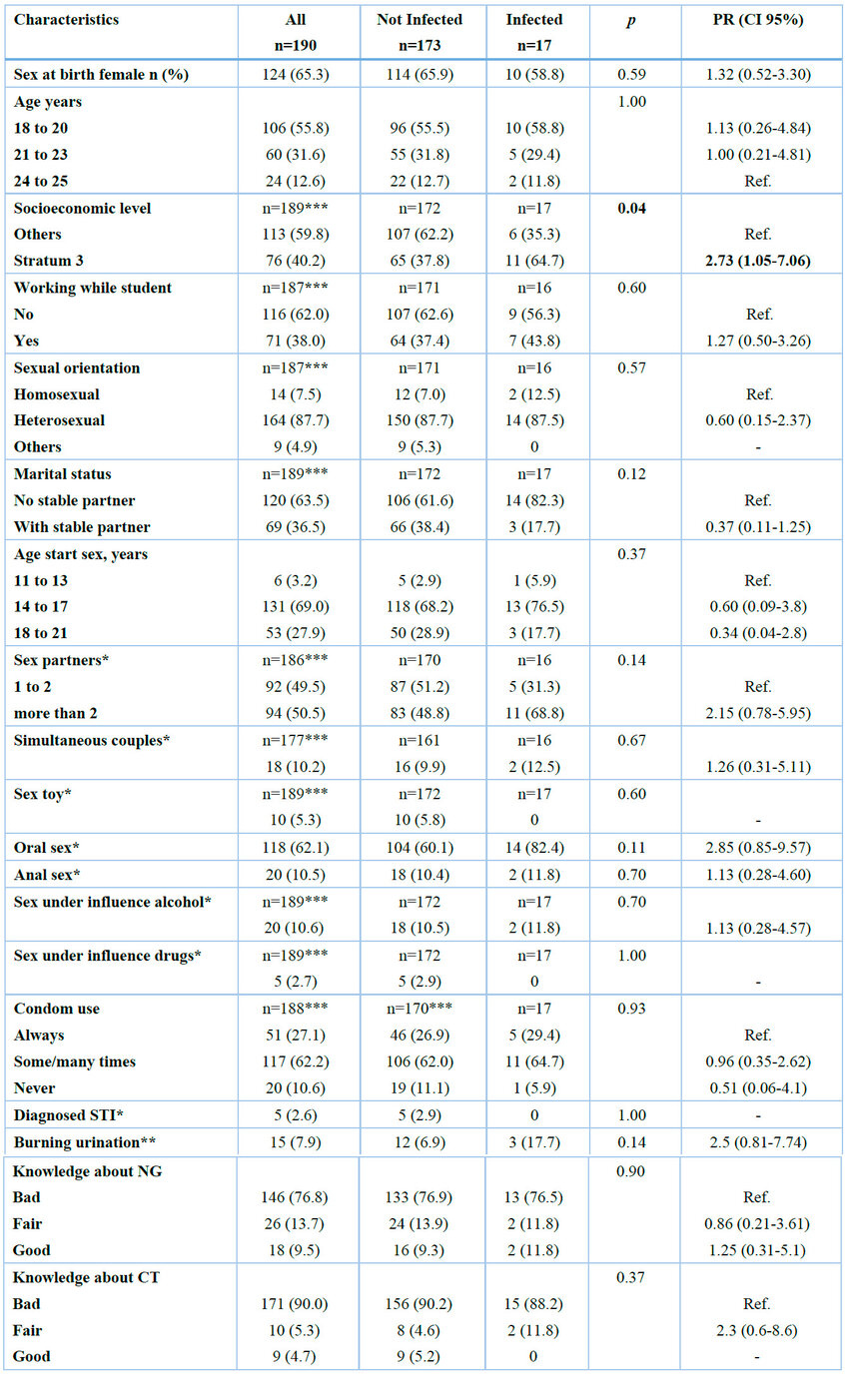
*In the last year. **In the last week. ***Some participants did not answer the question.
Table 1. Characteristics of participants according to infection status and factors associated with CT or NG infection.

*The 6 samples positive for the omp gene of CT were also positive for the Cryptic plasmid ORF3 gene of CT.
Table 2. Chlamydia trachomatis and Neisseria gonorrhoeae Prevalence
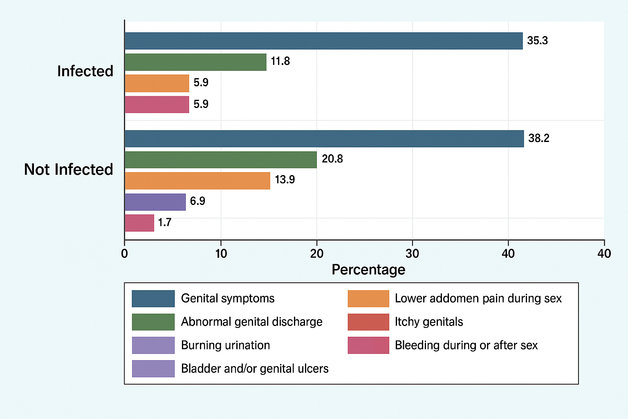
Figure 3. Comparison of genital symptoms in the last week between infected and non-infected university students in Bucaramanga, Colombia. The percentage of individuals in each category is shown for both groups.
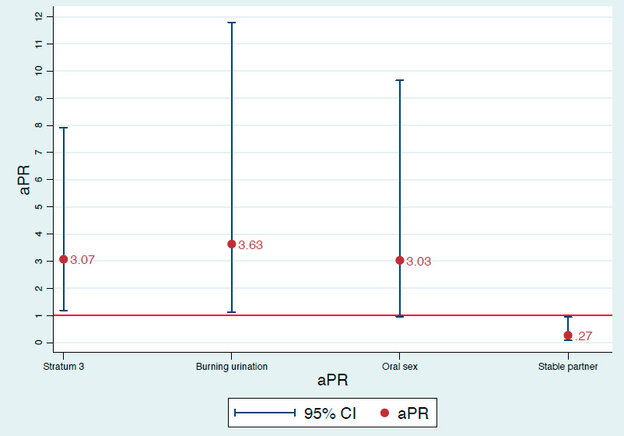
Figure 4. Factors independently associated with CT or NG infection. aPR: adjusted prevalence ratio. The final model included 188 participants who answered all the questions for the variables included in the model.
DISCUSSION
This cross-sectional study determined the prevalence of CT and NG in university students in Bucaramanga, Colombia, using molecular diagnostic methods. Additionally, it established the sociodemographic profile, sexual practices, STI-associated symptomatology, and knowledge of CT and NG.
The prevalence of CT and NG found in this study aligns with those reported for the Latin American region (LATAM) and is higher than the few national reports. For example, a recent systematic review estimated the burden of CT and NG infections in LATAM people under 20 years of age, establishing a prevalence of 3.2%–30.9% for CT and 0%–2.9% for NG 2. Similarly, a study on students from three universities in Medellín identified a CT prevalence of 2.6% and 1.5% in women and men, respectively; the presence of NG was not reported 6. Consistent with the above, the prevalence of CT and NG was also high when comparing the findings with non-university populations with similar characteristics. A study conducted in Bogota included women aged 15 to 24 and found a prevalence of 7.2% for CT and 0.4% for NG11. A related investigation identified a prevalence of 2.2% for CT and 0.1% for NG in adolescents aged 14 to 19 years enrolled in schools in Cundinamarca5.
These differences in the prevalence of CT and NG could be explained by the fact that about half of the population studied engaged in risky behaviors such as early sexual debut (between 14 and 17 years) and having more than two sexual partners in the past year. Therefore, these findings highlight the importance of implementing surveillance programs in high-risk populations to prevent health problems.
On the other hand, the prevalence identified for CT was lower, while that for NG was similar to international research reports. A study on Chilean university students identified a CT prevalence of 11.2% 12. Similarly, a survey among students of higher education institutions in Tanzania found a prevalence of 11% for CT and 1.1% for NG 13. Therefore, there is a need for epidemiological studies at the local level due to the heterogeneity in the prevalence of CT and NG, coupled with the limited available information2.
Compared to other populations, the prevalence found in women in this study was lower than that reported in a recent study of women aged 18 to 69 years (mean age: 23 years) at high risk of contracting STIs. This higher-risk group, defined by unprotected sexual intercourse with multiple partners in the past 12 months, a history of STIs, or engagement in sex work, had a prevalence of 13.4% for NG and 31.1% for CT. In addition to these risk factors, the difference could be explained by the fact that these women were recruited in STI clinics14.
Likewise, a study conducted among school-going adolescents (14–19 years old) reported a 15.8% positivity rate in the overall population, with a higher prevalence in females (21.6%) than in males (9.1%). Moreover, the study identified that factors such as multiple sexual partners and a history of pregnancy significantly increased the risk of infection in females. These findings highlight the vulnerability of adolescents to STIs and underscore the need for targeted screening strategies and comprehensive sex education for this population15.
Similarly, a study conducted in the general population of Slovenia estimated the prevalence of CT at 0.5% in men and 1.7% in women, with the highest burden of infection observed in the 18–24 age group (2.8% in men and 4.7% in women). Additionally, no cases of NG were detected, highlighting regional differences in the epidemiological dynamics of STIs16. Likewise, a study conducted in São Paulo over 11 years reported an overall CT prevalence of 2.2%, with higher rates among women under 25 (6.0%) and under 30 (4.4%)17. These findings indicate that the burden of infection is more significant among young women.
Furthermore, studies from other regions, such as Africa, Asia, and Eastern Europe, have also documented significant prevalence rates of Chlamydia trachomatis and Neisseria gonorrhoeae, underscoring the global relevance of our findings. For instance, research conducted in Tanzania found a CT prevalence of 11% and an NG prevalence of 1.1% among university students, while studies in Eastern Europe have reported CT rates ranging from 2% to 5% in similar age groups. Such data highlight common risk patterns among young adults across diverse sociocultural contexts.
In addition, the methodological approach employed in this study—including using self-collected samples, PCR-based molecular diagnostics, and structured behavioral surveys—can serve as a practical model for epidemiological surveillance in low-resource settings. This approach is particularly valuable in regions with limited diagnostic infrastructure and passive STI surveillance, as it facilitates early detection and enhances participation through non-invasive sampling methods.
Regarding factors associated with higher prevalence, the initiation of sexual intercourse stands out, with the 14-17 age group having the highest number of detected cases in this study. In addition, the type of sexual practice highlights positive cases associated with anal and oral sexual practices, as well as cases involving individuals under the influence of substances or alcohol. Furthermore, knowledge of the causative agents was generally poor, with 81% for NG and 90% for CT.
These results underscore the need to expand screening programs for young and at-risk populations and the importance of surveillance systems that accurately reflect the burden of these infections in the general population. Implementing opportunistic screening strategies in sexual and reproductive health services could significantly enhance early detection and proper management of these infections.
There are three main limitations. First, 9.1% of the participants were excluded due to insufficient sample quality for molecular testing, and it was impossible to collect another sample. Most were male (89.5%), highlighting the challenges of obtaining high-quality urine samples for molecular testing. Second, there were missing values for some variables (up to 6.8%) because participants did not answer the specific question, possibly due to the sensitivity of the information requested. Lastly, the sample size, sufficient to identify three factors independently associated with infection prevalence, lacked the statistical power to determine other factors, such as having had more than two sexual partners and engaging in oral sex in the past year. Additionally, this study was conducted among undergraduate students. Therefore, caution is advised when extrapolating these results to other populations.
Finally, some authors have pointed out the importance of local epidemiological studies in better understanding the burden of STIs in this population 2,4. In this regard, it is recommended that Colombia include mandatory reporting of CT and NG infections in SIVIGILA and active searches within high-risk populations. This would enable the identification of prevalence, establishment of transmission dynamics, and the implementation of containment measures for these infections.
CONCLUSIONS
This study highlights a concerning prevalence of Chlamydia trachomatis and Neisseria gonorrhoeae among university students in Bucaramanga, Colombia, according to previously reported national data. Factors associated with these infections, such as low socioeconomic status and high-risk sexual behaviors, underscore the urgent need to implement active epidemiological surveillance programs in this population. Additionally, improving education on sexually transmitted infections is essential to reduce risky behaviors and promote preventive practices. Including these infections in mandatory reporting systems like SIVIGILA would enable a better understanding of their transmission dynamics and support the development of effective interventions to mitigate their public health impact.
Implications for Public Health Practice
- Implementing STI screening programs in university settings could reduce the prevalence of Chlamydia trachomatis and Neisseria gonorrhoeae by over 50%, particularly among asymptomatic young adults.
- Integrating molecular testing for CT and NG into primary healthcare services is a cost-effective strategy for early detection and treatment.
- The use of self-collected vaginal and urine samples enhances participation rates and acceptability among young populations, especially in low-resource or culturally sensitive settings.
- Routine surveillance of bacterial STIs should be expanded in Latin American countries to better inform prevention and control strategies.
- Educational interventions addressing STI awareness and risk perception are essential to reduce high-risk sexual behaviors in youth.
Author Contributions: LBD, JASS, RAMV conceived and designed the research. LBD, MYAG, JASS performed experiments and analyzed data. GRC provided expert opinion and editing suggestions. JASS, LBD, RAMV, and MYAG prepared tables and wrote the manuscript. All authors of this paper have read and approved the final version submitted.
Funding: Proyect CIF19-20, Universidad de Santander (UDES).
Acknowledgments: The authors would like to extend their deepest gratitude to Maria Juliana Rolón Rojas for her guidance and support in designing the primers used in our study.
Conflicts of Interest: The authors of this paper declare that they have no competing financial and non-financial interests concerning the publication of this work.
REFERENCES
1. Gaitán-Duarte H. Sexually transmitted infections: A public health problem Colombia must face. Rev Colomb Obstet Ginecol. 2017;68(3):164–7. doi: 10.18597/rcog.3080
2. Vallejo-Ortega MT, Duarte HG, Mello MB, Caffe S, Perez F. A systematic review of the prevalence of selected sexually transmitted infections in young people in Latin America. Rev Panam Salud Publica/Pan Am J Public Heal. 2022;46:1–11.doi:10.26633/RPSP.2022.73
3. Xu Y, Aboud L, Chow EPF, Mello MB, Wi T, Baggaley R, et al. The diagnostic accuracy of pooled testing from multiple individuals for the detection of Chlamydia trachomatis and Neisseria gonorrhoeae: a systematic review. Int J Infect Dis. 2022;118:183–93. doi:10.1016/j.ijid.2022.03.009
4. Instituto Nacional de Salud. Sistema de Vigilancia en Salud Pública - SIVIGILA. [Internet]. Date of access: February 25, 2023. Available from: https://www.ins.gov.co/Direcciones/Vigilancia/Paginas/SIVIGILA.aspx
5. Paredes MC, Gómez YM, Torres AM, Fernández M, Tovar MB. Prevalencia de infecciones por Chlamydia trachomatis y Neisseria gonorrhoeae en adolescentes de colegios de la provincia de Sabana Centro, Cundinamarca, Colombia. Biomedica. 2015;35(3):314–24. doi:10.7705/biomedica.v35i3.2398
6. Cuervo-Araque CM, Gaviria-Nuñez AM, Quiroga-Sierra AC, González-Niño A. Chlamydia trachomatis, herpes simplex virus-2 and Neisseria gonorrhoeae: Prevalence and risk factors in students. Rev Salud Pública. 2021;23(5):1–7. doi: 10.15446/rsap.V23n5.91054
7. Torrado-García LM, Martínez-Vega RA, Rincon-Orozco B. A Novel Strategy for Cervical Cancer Prevention Using Cervical-Vaginal Self-Collected Samples Shows High Acceptability in Women Living in Low-Income Conditions from Bucaramanga, Colombia. Int J Womens Health. 2020; 12: p. 1197-1204. doi:10.2147/IJWH.S265130
8. Priyadarshi K, Prakash P, Rani A, Singh SK. Multiplex nested polymerase chain reaction targeting multiple genes for the detection of Neisseria gonorrhoeae and Chlamydia trachomatis in genitourinary specimens. Indian J Sex Transm Dis AIDS. 2019;40(2):152-8.
9. Mahmoodi P, Motamedi H, Seyfi Abad Shapouri MR, Bahrami Shehni M, Kargar M. Molecular Detection and Typing of Human Papillomaviruses in Paraffin-Embedded Cervical Cancer and Pre-Cancer Tissue Specimens. Iran J Cancer Prev. 2016;22;9(1):e3752. doi: 10.17795/ijcp-3752.
10. Flores-Mireles AL, Walker JN, Caparon M, Hultgren SJ. Urinary tract infections: epidemiology, mechanisms of infection and treatment options. Nat Rev Microbiol. 2015;13(5):269-284. doi:10.1038/nrmicro3432 .
11. Franceschi S, Smith JS, Van Den Brule A, Herrero R, Arslan A, Anh PTH, et al. Cervical infection with Chlamydia trachomatis and Neisseria gonorrhoeae in women from ten areas in four continents: A cross-sectional study. Sex Transm Dis. 2007;34(8):563–9. doi: 10.1097/01.olq.0000258417.66619.0e.
12. Melo A, Lagos N, Montenegro S, Orellana JJ, Vásquez AM, Moreno S, et al. Virus papiloma humano y Chlamydia trachomatis según número de parejas sexuales y tiempo de actividad sexual en estudiantes universitarias en la Región de La Araucanía, Chile. Rev Chil Infectol. 2016;33(3):287–92. doi:10.4067/S0716-10182016000300006
13. McHaro RD, Kisinda A, Njovu L, McHaro M, Mbwilo F, Mihale G, et al. Prevalence of and risk factors associated with HIV, Herpes Simplex Virus-type 2, Chlamydia trachomatis and Neisseria gonorrhoeae infections among 18–24 year old students attending Higher Learning Institutions in Mbeya-Tanzania. PLoS One. 2022;17:1–15. doi:10.1371/journal.pone.0266596
14. Shephard M, Matthews S, Kularatne R, Andrewartha K, Blondeel K, Alvarez C, et al. Independent clinic-based evaluation of point-of-care testing for the screening of Chlamydia trachomatis, Neisseria gonorrhoea and Trichomonas vaginalis in women-at-risk in Australia, Guatemala, Morocco, and South Africa. BMC Infectious Diseases. 2024;24(1):277. doi.org/10.1186/s12879-024-09018-4.
15. Gabster A, Mayaud P, Ortiz A, Castillo J, Castillero O, Martínez A, et al. Prevalence and determinants of genital Chlamydia trachomatis among school-going, sexually experienced adolescents in urban and rural Indigenous regions of Panama. Sex Transm Infect. 2021;97(4):304-11. doi. 10.1136/sextrans-2019-054395
16. Klavs I, Milavec M, Berlot L, Kustec T, Grgič-Vitek M, Lavtar D, et al. Prevalence of sexually transmitted infections with Chlamydia trachomatis, Neisseria gonorrhoeae, Mycoplasma genitalium and Trichomonas vaginalis: findings from the National Survey of Sexual Lifestyles, Attitudes and Health, Slovenia, 2016 to 2017. Euro Surveill. 2022;27(14):2100284. doi. 10.2807/1560-7917.ES.2022.27.14.2100284
17. Campaner AB, de Castro MA, Lucarelli AP. Chlamydia trachomatis prevalence in females in São Paulo, Brazil: 11 years' surveillance of the infection. Braz J Microbiol. 2022;54(1):151-8. doi.org/10.1007/s42770-022-00865-4
Received: January 20, 2025 / Accepted: April 2, 2025 / Published: June 15, 2025
Citation: Arias-Guerrero M, Silva-Sayago J, Rincon-Cruz G, Martinez-Vega R, Benitez-Diaz L. Sexually Transmitted Infections in Colombian University Students: Prevalence and Associated Factors of Chlamydia trachomatis and Neisseria gonorrhoeae. Bionatura journal. 2025;2 (2):5. doi: 10.70099/BJ/2025.02.021.5
Additional information Correspondence should be addressed to lilianabenitezdiaz@gmail.com
Peer review information. Bionatura thanks anonymous reviewer(s) for their contribution to the peer review of this work using https://reviewerlocator.webofscience.com/
ISSN.3020-7886
All articles published by Bionatura Journal are made freely and permanently accessible online immediately upon publication, without subscription charges or registration barriers.
Publisher's Note: Bionatura Journal stays neutral concerning jurisdictional claims in published maps and institutional affiliations.
Copyright: © 2025 by the authors. They were submitted for possible open-access publication under the terms and conditions of the Creative Commons Attribution (CC BY) license (https://creativecommons.org/licenses/by/4.0/).
How to cite this article:
Arias-Guerrero M, Silva-Sayago J, Rincón-Cruz G, Martínez-Vega R, Benítez-Díaz L. Sexually Transmitted Infections in Colombian University Students: Prevalence and Associated Factors of Chlamydia trachomatis and Neisseria gonorrhoeae. BioNatura Journal. 2025; 2(2):5. DOI: 10.70099/BJ/2025.02.02.5




